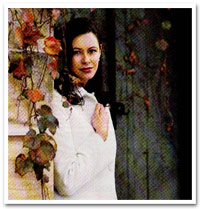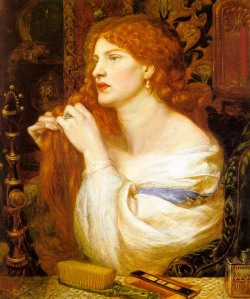Today we have the lovely Kate Forsyth visting us to coincide with the release of her new book Bitter Greens. There is a copy of Bitter Greens for one lucky reader. See the give-away question at the end.

Rapunzel is one of the most mysterious and enduring of all fairytales, telling the story of a young girl sold to a witch by her parents for a handful of bitter green herbs.
Most people think that the ‘Rapunzel’ story was first told by the Grimm Brothers in the early 19th century, but in fact it is a much older tale than that. There are so many ‘Maiden in the Tower’ stories in cultures all around the world that it has its own classification in the Aarne-Thompson fairytale motif index (Type 310).
The first known version is from Christian iconography with the story of Saint Barbara. She was a virtuous young girl locked in a tower by her father in the 3rd century. She was tortured for her Christian beliefs but her wounds miraculously healed overnight and when she was beheaded by her father, he was struck by lightning and killed. Most images of her show her with long, flowing, blonde hair, and in one version of the story her hair miraculously burst into flame when her father seized hold of it.
The first appearance of the motif of the ‘hair ladder’ was in a 10th century Persian tale told by Ferdowsi (932-1025 AD), in which a woman in a harem offers to lower her hair to her lover so he can climb up to her. He is afraid he might hurt her and so throws up a rope instead.
The ‘hair ladder’ reappears in Petrosinella, a literary fairy tale told by a Florentine writer, Giambattista Basile and published in 1634. Basile was living in Venice at the time and so may have heard many tales brought by sailors and merchants from faraway lands. Petrosinella (Little Parsley) is given up to an ogress after her mother steals parsley from the ogress’s garden. The ogress locks Petrosinella up in a tower in the forest, using her hair as a ladder to access the building. Petrosinella escapes with the help of a prince who heard her singing, overcoming the ogress by casting three magical acorns behind her that turn into obstacles that impede the witch and ultimately devour her.
Sixty years later, the story appears again, this time in France. It is told in 1698 by Charlotte-Rose de Caumont de la Force , who has been banished to a convent after displeasing the Sun King, Louis XIV, at his opulent court in Versailles. Locked away in a cloister, much like Rapunzel is in her tower, Charlotte-Rose was among the first writers to pen a collection of literary fairy tales and also one of the world’s first historical novelists. Published under a pseudonym, Mademoiselle X, Charlotte-Rose’s tales became bestsellers and she was eventually able to buy her release.
In Persinette, Mademoiselle de la Force’s version of the tale, the mother conceives an insatiable longing for parsley which her husband steals for her from a sorceress’s garden. When he is caught by the sorceress, the husband promises the sorceress his unborn daughter. The sorceress comes and collects the little girl at the age of seven, names her Persinette, and raises her until she is twelve. Persinette is then locked away in a tower without a door or stair, deep in a forest.
In time she becomes a woman; the prince hears her singing and chants the rhyme so he can climb up the ladder of hair to her room, where he seduces her. “He became bolder and proposed to marry her right then and there, and she consented without hardly knowing what she was doing. Even so, she was able to complete the ceremony” is how Charlotte-Rose rather coyly describes his seduction.
Persinette becomes pregnant as a result, and in her naivety betrays herself to the sorceress when she complains about her dress growing tighter. The sorceress is furious. She cuts off Persinette’s hair and banishes her to a far-distant wilderness, then tricks the prince into climbing up the braids to the tower. She then causes him to fall from the tower to the ground, and he is blinded by the thorns that grow about the base of the tower. Persinette bears twins in the wilderness, then finds the prince and heals his eyes with her tears. The sorceress continues to torment them, until the young couple’s courage and tender love for each other move her to mercy and she magically returns them to the prince’s loving family.
The story was then retold by the German author Friedrich Schulz (1790). His version is almost identical to Mademoiselle de la Force’s, except that he changed the girl’s name to Rapunzel. It was then retold by the Grimm Brothers (1812), becoming less powerful, mysterious and sexually charged with each subsequent edition. For example, Rapunzel betrays the prince by remarking that the witch is much heavier to pull up, rather than by the witch’s realization that Rapunzel is pregnant.
I love Charlotte-Rose de la Force’s version of the story because of the ardent love affair and the miraculous healing of the prince’s eyes, and also because the heroine takes a more active role than in later versions of the tale. Persinette is imprisoned as a child, but she survives her ordeal, plots her escape, falls in love, and then raises two children on her own. She heals her lover’s wounds with her tears, and she persuades the sorceress to set them free. She becomes a magical agent of healing and salvation, not only for herself and her family, but also for the sorceress.
I am also fascinated by Charlotte-Rose herself. Strong-willed, intelligent and fiercely independent, she  once rescued her lover from imprisonment by disguising herself as a dancing bear and entering his father’s castle with a travelling troupe of performers. Her stories were among the first literary fairy tales to be published, and her historical novels are known to have been read and enjoyed by Sir Walter Scott, who many attribute with beginning the historical fiction genre. Her most famous novel, The Secret History of Margeurite de Valois (1697), was also a strong influence on Alexander Dumas’s novel The Queen Margot (1854). She was an early feminist who believed passionately in free love and fought to live her own life liberated from the rigid hierarchy and etiquette of the court of Louis XIV. I find it interesting that her own story echoes the themes of Persinette – she is locked away from society by the king, but she wins her freedom by telling stories.
once rescued her lover from imprisonment by disguising herself as a dancing bear and entering his father’s castle with a travelling troupe of performers. Her stories were among the first literary fairy tales to be published, and her historical novels are known to have been read and enjoyed by Sir Walter Scott, who many attribute with beginning the historical fiction genre. Her most famous novel, The Secret History of Margeurite de Valois (1697), was also a strong influence on Alexander Dumas’s novel The Queen Margot (1854). She was an early feminist who believed passionately in free love and fought to live her own life liberated from the rigid hierarchy and etiquette of the court of Louis XIV. I find it interesting that her own story echoes the themes of Persinette – she is locked away from society by the king, but she wins her freedom by telling stories.
In my novel, Bitter Greens, I have entwined a retelling of the Rapunzel fairy tale with Charlotte-Rose’s dramatic life story to create a novel of desire, obsession, black magic, and the redemptive power of love. Oh, and Giambattista Basile makes a brief appearance too …
Don’t you love it, when someone really knows their stuff? Kate’s currently overseas staying in the Sleeping Beauty castle at Sababurg. She’ll be back mid week.
Here’s the give-away question: What is your favourite fairy tale and why?



